Text consolidated by Valsts valodas centrs (State
Language Centre) with amending laws of:
28 September 2006 [shall
come into force on 27 October 2006];
20 December 2007 [shall come into force on 23 January
2008];
1 December 2009 [shall come into force on 1 January
2010];
15 April 2010 [shall come into force on 1 May 2010].
If a whole or part of a section has been amended, the
date of the amending law appears in square brackets at
the end of the section. If a whole section, paragraph or
clause has been deleted, the date of the deletion appears
in square brackets beside the deleted section, paragraph
or clause.
|
The Saeima1
has adopted and
the President has proclaimed the following law:
Law on State
Honours
Chapter I
General Provisions
Section 1. This Law prescribes the procedures for the
establishment, bestowal, and wearing of the State honours of
Latvia (hereinafter - the State honours).
Section 2. (1) Such State honours exist in Latvia which
are established by this Law and the law On the Commemorative
Medal for Participants of the Barricades of 1991.
(2) State authorities, local governments, and public
organisations may establish their own honours. The procedures for
the establishment of the State authority and local government
honours shall be determined by the Cabinet.
Section 3. The State honours are the orders specified
in this Law and their medals of honour, and also the
Commemorative Medal for Participants of the Barricades of 1991
(hereinafter also - the Commemorative Medal).
Section 4. (1) The order is the highest State honour
bestowed for special merits for the benefit of Latvia. The order
has several classes.
(2) The order's medal of honour is the State honour bestowed
for a significant contribution to the State, local government,
public, or economic activities. The medal of honour has several
levels.
Section 5. The State honours are as follows:
1) the Order of the Three Stars and its Medal of Honour;
2) the Order of Viesturs and its Medal of Honour;
3) the Cross of Recognition and its Medal of Honour;
4) the Commemorative Medal for Participants of the Barricades
of 1991.
[15 April 2010]
Section 6. The bestowal of the order or its medal of
honour and also of the Commemorative Medal does not constitute
any advantage to the recipients of the honours.
Section 7. It is prohibited to establish or bestow an
honour in Latvia the purpose, motto, description, or visual
appearance whereof does not differ significantly from the State
honours or which, by its nature, infringes the rights of other
people, the democratic structure of the State, public safety,
welfare, and morals.
Section 8. (1) The drawings of orders and their medals
of honour, miniature versions, miniature medals of honour,
ribbons, diplomas, and certificates, the drawings of the statutes
of orders, the drawings of the stamps of orders and their medals
of honour shall be assessed by the State Heraldry Commission and
approved by its chairperson.
(2) The drawings of honours established by State authorities,
local governments, and public organisations shall be assessed and
approved by the State Heraldry Commission.
(3) The drawings of orders and their medals of honour,
miniature versions, miniature medals of honour, ribbons,
diplomas, and certificates, the drawings of the statutes of
orders, the drawings of the stamps of orders and their medals of
honour, and also the templates intended for creating the marks of
orders are the work of an author and the author has exclusive
rights to these drawings and templates.
Section 9. (1) The State shall cover the costs related
to the production of orders and their medals of honour, miniature
versions, miniature medals of honour, Commemorative Medals and
their small badges, diplomas, certificates, and statutes, except
for the case referred to in Section 61, Paragraph two of this
Law.
(2) The Chancery of the President shall:
1) organise the production of the State honours, except for
the Commemorative Medals for Participants of the Barricades of
1991, and control the production process thereof;
2) store the State honours which have not been bestowed and
which are referred to in Section 61, Paragraph one of this Law,
except for the Commemorative Medals for Participants of the
Barricades of 1991.
(3) [15 April 2010]
[1 December 2009; 15 April 2010]
Chapter
II
Statutes of the Order of the Three Stars and Its Medal of
Honour
Section 10. (1) The Order of the Three Stars was
established in 1924 in commemoration of the establishment of the
State of Latvia and was reinstated in 1994.
(2) The Order of the Three Stars is the highest State
honour.
(3) The motto for the Order of the Three Stars is "Per aspera
ad astra" ("Through Hardships to the Stars").
[15 April 2010]
Section 11. (1) The Order of the Three Stars
(hereinafter in this Chapter also - the Order) is bestowed for
meritorious service to the Fatherland. Meritorious service to the
Fatherland for which the Order of the Three Stars is bestowed may
be related to State, local government, public, cultural,
educational, scientific, sports-related, or economic
activities.
(2) Meritorious service refers to outstanding individual
accomplishments, to long-term and exemplary achievements, and to
particular merit during the period of restoring the independence
of Latvia or during further strengthening of the State.
(3) The Order of the Three Stars and its Medal of Honour may
be bestowed on natural persons, including military personnel and
foreign natural persons.
(4) The Order of the Three Stars may be bestowed on the heads
of foreign states and foreign governments, leaders of
international organisations, foreign ambassadors, and other
foreign officials.
[28 September 2006]
Section 12. (1) The Order of the Three Stars has five
classes and three levels of Medals of Honour.
(2) A recipient of the Order of the First Class is appointed
as the Commander of the Great Cross of the Order (Annexes 1 and 2
to this Law), a recipient of the Order of the Second Class - the
Grand Officer of the Order (Annexes 3 and 4 to this Law), a
recipient of the Order of the Third Class - the Commander of the
Order (Annexes 5 and 6 to this Law), a recipient of the Order of
the Fourth Class - the Officer of the Order (Annex 7 to this
Law), a recipient of the Order of the Fifth Class - the Bearer of
the Order (Annex 8 to this Law).
(3) The Commander of the Great Cross of the Order of
particular distinction may be bestowed the Chain of the Order of
the Three Stars (Annexes 9 and 10 to this Law).
[15 April 2010]
Section 13. (1) The mark of the Order of the Three
Stars is a white enamel cross with a gilded edge. A blue enamel
medallion with a gilded edge is at the obverse centre of the
cross. There are three gold stars at the centre of the medallion
(Annex 11 to this Law). A gilded medallion with the motto of the
Order "PER ASPERA AD ASTRA" and the inscription
"LATVIJAS/REPUBLIKA/1918.G.18.NO/VEMBRIS / 1994" is at the
reverse centre of the cross (Annex 12 to this Law).
(2) The dimensions of the cross of the Order of the First
Class are 54 mm x 54 mm, the dimensions of the cross of the Order
of the Second Class and the Third Class are 49 mm x 49 mm, and
the dimensions of the cross of the Order of the Fourth Class and
the Fifth Class are 40 mm x 40 mm.
(3) The set of the Order of the First Class and the Second
Class also includes a five-pointed silver star with a blue enamel
medallion with a gilded edge at its centre. There are three gold
stars at the centre of the medallion, and there is the
inscription "PAR TĒVIJU" ("FOR THE FATHERLAND") on the edge. The
distance from the centre of the Order of the First Class star to
the tips of the points of the star is 44 mm, while the distance
from the centre of the Order of the Second Class star to the tips
of the points of the star is 41 mm.
(4) The ribbon of the Order of the Three Stars is light blue,
double-folded with gilded stripes. The mark and the ribbon of the
Order are linked by a gilded silver wreath of oak leaves. The
width of the ribbon of the Order for Commanders of the Great
Cross is 110 mm for men and 75 mm for ladies; for Grand Officers
it is 32 mm (tied in a bow for ladies); for Commanders it is 32
mm (tied in a bow for ladies); for Officers it is 32 mm with a
rosette; for Bearers it is 32 mm.
[15 April 2010]
Section 14. The Chain of the Order of the Three Stars
is 940 mm long and it consists of 10 gilded links; the medallion
of the Order, images of a lion and a gryphon, and a double cross
of fire are carved into the links.
Section 15. (1) The Medal of Honour of the Order of the
Three Stars is a round medal with a diameter of 30 mm. On the
obverse of the Medal of Honour there is an image of the cross of
the Order (Annex 13 to this Law), whereas on the reverse there is
the inscription "PAR/TĒVIJU" and a flaming heart below it. The
medal is encircled with a wreath of oak leaves (Annex 14 to this
Law).
(2) The Medal of Honour of the Order of the Three Stars of the
First Level is gilded, that of the Second Level is silvered, and
that of the Third Level is bronzed (Annex 13 to this Law).
(3) The width of the ribbon of the Medal of Honour of the
Order of the Three Stars is 32 mm.
[15 April 2010]
Section 16. (1) Miniature versions of the Order of the
Three Stars are identical for all classes of the Order (Annex 15
to this Law).
(2) The miniature versions are as follows:
1) a miniature mark of the Order with the dimensions of 14 mm
x 14 mm linked to a ribbon of the Order that is 13 mm wide;
2) a rosette for the ribbon of the Order with a miniature mark
of the Order with a diameter of 12 mm;
3) a piece of the ribbon of the Order with the dimensions of 9
mm x 32 mm.
[15 April 2010]
Section 17. The miniature versions for the Medal of
Honour of the Order of the Three Stars are as follows:
1) a miniature Medal of Honour of the Order with a folded
triangular ribbon, gilded for the First Level, silvered for the
Second Level, and bronzed for the Third Level (Annexes 16 and 17
to this Law). The diameter of the miniature Medal of Honour of
the Order is 12 mm and the width of the ribbon is 13 mm;
2) a piece of the ribbon of the Order with a five-pointed
star, gilded for the First Level, silvered for the Second Level,
and bronzed for the Third Level (Annex 16 to this Law). The
dimensions of the piece of ribbon are 9 mm x 32 mm and the
diameter of the star is 8 mm.
[15 April 2010]
Section 18. [15 April 2010]
Section 19. [15 April 2010]
Chapter
III
Statutes of the Order of Viesturs and Its Medal of Honour
Section 20. (1) The Order of Viesturs (Vesthardus
Rex) was established in 1938 in commemoration of the ancient
might of Latvia and is reinstated by this Law.
(2) The motto for the Order is "Confortamini et pugnate" ("Be
Strong and Fight").
Section 21. (1) The Order of Viesturs (hereinafter in
this Chapter also - the Order) is bestowed for outstanding
military achievements, and also for outstanding achievements in
the national resistance movement and defending the country's
independence, for maintaining and strengthening national security
and public order, for protecting the country's borders, for
shaping the National Armed Forces and enhancing civic
consciousness in citizens so as to train them to serve their
country and their land, and for the constant defence of one's
country and land.
(2) The Order of Viesturs and its Medal of Honour are bestowed
on military personnel, and also on other natural persons.
(3) The Order of Viesturs and its Medal of Honour may be
bestowed on foreign military personnel for merits in training and
educating the National Armed Forces of Latvia, for maintaining
and strengthening national security and public order.
(4) The Order of Viesturs may also be bestowed on heads of
foreign states and members of official foreign delegations, and
also foreign ambassadors for notable contribution to shaping
international relations.
(5) The Order of Viesturs may be bestowed posthumously if the
Chapter of Orders takes the decision on recognition of a person
as the Commander of the Great Cross of the Order of Viesturs.
This provision shall not apply to the case referred to in
Paragraph four of this Section.
[28 September 2006; 15 April 2010]
Section 22. (1) The Order of Viesturs has five classes
and three levels of Medals of Honour.
(2) A recipient of the Order of the First Class is appointed
as the Commander of the Great Cross of the Order (Annexes 18, 19,
20, and 21 to this Law), a recipient of the Order of the Second
Class - the Grand Officer of the Order (Annexes 22, 23, 24, and
25 to this Law), a recipient of the Order of the Third Class -
the Commander of the Order (Annexes 26, 27, 28, and 29 to this
Law), a recipient of the Order of the Fourth Class - the Officer
of the Order (Annexes 30 and 31 to this Law), a recipient of the
Order of the Fifth Class - the Bearer of the Order (Annexes 32
and 33 to this Law).
[15 April 2010]
Section 23. (1) The mark of the Order of Viesturs is a
white enamel cross with a gilded edge. There is a red enamel
circle with a gilded edge and a gilded globule at the ends of the
points of the cross, whereas on either side of the red enamel
circle there are smaller red enamel circles with gilded edges.
There is a white enamel medallion with a raised gilded edge at
the obverse centre of the cross, whereas the letters "VR" with a
gilded edge are in the centre of the medallion in red enamel
(Annex 34 to this Law). A gilded medallion with the motto of the
Order "CONFORTAMINI ET PUGNATE" is at the reverse centre of the
cross. In the middle - the year "1219" (Annex 35 to this
Law).
(2) The mark of the Order to be bestowed on military personnel
bears crossed gilded spears between the points of the cross
(Annex 34 to this Law), the mark of the cross in the mark of the
Order to be bestowed on other natural persons bears a split white
enamel cross with a gilded edge (Annex 34 to this Law).
(3) The dimensions of the cross of the Order of the First
Class are 58 mm x 58 mm, the dimensions of the cross of the Order
of the Second Class and the Third Class are 52 mm x 52 mm, and
the dimensions of the cross of the Order of the Fourth Class and
the Fifth Class are 40 mm x 40 mm.
(4) The set of the Order of the First Class and the Second
Class also includes a four-pointed silver star with the mark of
the Order at its centre. The star is 87 mm x 87 mm in dimensions
for the Order of the First Class and 80 mm x 80 mm in dimensions
for the Order of the Second Class.
(5) The ribbon for the Order is crimson. The cross and the
ribbon are linked with the greater State coat of arms in the
colours of heraldry. The width of the ribbon of the Order for
Commanders of the Great Cross is 110 mm for men and 75 mm for
ladies; for Grand Officers it is 32 mm (tied in a bow for
ladies); for Commanders it is 32 mm (tied in a bow for ladies);
for Officers it is 32 mm with a rosette; for Bearers it is 32
mm.
[15 April 2010]
Section 24. (1) The Medal of Honour of the Order of
Viesturs is a round medallion with a diameter of 30 mm. There is
a depiction of the Cross of the Order on the obverse of the Medal
of Honour and the motto "CONFORTAMINI/ET/PUGNATE" is on the
reverse with crossed oak branches underneath.
(2) The Medal of Honour of the Order of Viesturs of the First
Level is gilded, that of the Second Level is silvered, and that
of the Third Level is bronzed (Annexes 36 and 37 to this
Law).
(3) The width of the ribbon of the Medal of Honour of the
Order of Viesturs is 32 mm.
[15 April 2010]
Section 25. (1) Miniature versions of the Order of
Viesturs are identical for all classes of the Order (Annexes 38
and 39 to this Law).
(2) The miniature versions are as follows:
1) a miniature mark of the Order the dimensions of which are
15 mm x 15 mm, the mark of the Order to be bestowed on military
personnel bears crossed gilded spears between the points of the
cross in the mark of the Order, while the mark of the cross in
the mark of the Order to be bestowed on other natural persons has
a split white enamel cross with a gilded edge. The miniature mark
of the Order is linked to a ribbon of the Order that is 13 mm
wide;
2) a rosette of the ribbon of the Order with a miniature mark
of the Order at a diameter of 12 mm, the mark of the Order to be
bestowed on military personnel bears crossed gilded spears
between the points of the cross in the mark of the Order, while
the mark of the cross in the mark of the Order to be bestowed on
other natural persons has a split white enamel cross with a
gilded edge;
3) a piece of the ribbon of the Order the dimensions of which
are 9 mm x 32 mm, crossed 18 mm spears are on the ribbon of the
Order bestowed on military personnel.
[15 April 2010]
Section 26. The miniature versions of the Medals of
Honour of the Order of Viesturs are as follows (Annexes 40 and 41
to this Law):
1) a miniature Medal of Honour of the Order with a folded
triangular ribbon, gilded for the First Level, silvered for the
Second Level, and bronzed for the Third Level. The diameter of
the miniature Medal of Honour of the Order is 12 mm and the width
of the ribbon is 13 mm;
2) a piece of the ribbon of the Order with a five-pointed
star, gilded for the First Level, silvered for the Second Level,
and bronzed for the Third Level. The dimensions of the piece of
ribbon are 9 mm x 32 mm and the diameter of the star is 4 mm.
[15 April 2010]
Section 27. [15 April 2010]
Section 28. [15 April 2010]
Chapter
IV
Statutes of the Cross of Recognition and Its Medal of Honour
Section 29. (1) The Cross of Recognition (Croix de
la reconnaissance) was established in Liepāja in 1710 and
re-established in the Republic of Latvia in 1938 in commemoration
of the glory days of the Duchy of Kurzeme and Zemgale and is
reinstated by this Law.
(2) The motto for the Cross of Recognition is "Pour les
honnêtes gens" ("For Honest People").
Section 30. (1) The Cross of Recognition (hereinafter
in this Chapter also - the Order) is bestowed for outstanding
love of the Fatherland and for outstanding merits in national
affairs, public work, culture, science, sports, and education.
Loyal and faithful service to the State or a local government,
exemplary and honest performance of work, any public services,
and the development of the spirit of the people and their ability
to do work and the strength of an economic nature are considered
merits.
(2) The Cross of Recognition and its Medal of Honour may be
bestowed on natural persons, also foreign natural persons.
(3) The Cross of Recognition may be bestowed on the heads of
foreign states and foreign governments, leaders of international
organisations, foreign ambassadors, and other foreign
officials.
[28 September 2006]
Section 31. The Cross of Recognition has five classes
and three levels of Medals of Honour.
[15 April 2010]
Section 32. A recipient of the Order of the First Class
is appointed as the Commander of the Great Cross of the Order
(Annexes 42 and 43 to this Law), a recipient of the Order of the
Second Class - the Grand Officer of the Order (Annexes 44 and 45
to this Law), a recipient of the Order of the Third Class - the
Commander of the Order (Annexes 46 and 47 to this Law), a
recipient of the Order of the Fourth Class - the Officer of the
Order (Annex 48 to this Law), a recipient of the Order of the
Fifth Class - the Bearer of the Order (Annex 49 to this Law).
[15 April 2010]
Section 33. (1) The Cross of Recognition is a white
enamel Maltese cross with a gilded edge. There is a globule at
each corner, with eight rings linking the joints. The greater
State coat of arms and the year "1938" are on the obverse of the
cross of the medallion (Annex 50 to this Law). On the reverse -
the coat of arms of the duchy, along with the year "1710" (Annex
51 to this Law). Both coats of arms are presented in their
heraldic colours. The motto is engraved at the ends of the three
points of the cross as follows: "pour / les - honn / êtes - ge /
ns".
(2) The dimensions of the cross of the Order of the First
Class, the Second Class, and the Third Class are 49 mm x 49 mm,
the dimensions of the cross of the Order of the Fourth Class and
the Fifth Class are 40 mm x 40 mm.
(3) The set of the Order of the First Class and the Second
Class is accompanied by an eight-pointed silver star with the
mark of the Order at its centre. The star is 75 mm x 75 mm in
dimensions for the Order of the First Class and 70 mm x 70 mm in
dimensions for the Order of the Second Class.
(4) The cross and the ribbon of the Order are linked with
eight gilded rings.
(5) The ribbon of the Order is red with silver edging. The
width of the ribbon of the Order for Commanders of the Great
Cross is 110 mm for men and 75 mm for ladies; for Grand Officers
it is 32 mm (tied in a bow for ladies); for Commanders it is 32
mm (tied in a bow for ladies); for Officers it is 32 mm with a
rosette; for Bearers it is 32 mm.
[15 April 2010]
Section 34. (1) The Medal of Honour of the Cross of
Recognition is a round medal with a raised image of the Cross of
Recognition on the obverse (Annex 52 to this Law), and there is
an emblem on the reverse - a crown with a ring and the
inscription "DOMAS - UN - DARBUS - LATVIJAI" ("THOUGHTS - AND -
WORK - FOR - LATVIA") (Annex 53 to this Law).
(2) The Medal of Honour of the Cross of Recognition of the
First Level is gilded, that of the Second Level is silvered, and
that of the Third Level is bronzed (Annex 52 to this Law). The
diameter of the Medal of Honour is 36 mm.
(3) The width of the ribbon of the Medal of Honour of the
Cross of Recognition is 32 mm.
[15 April 2010]
Section 35. (1) The miniature versions of the Cross of
Recognition are identical for all classes of the Order (Annex 54
to this Law).
(2) The miniature versions are as follows:
1) a miniature mark of the Order with the dimensions of 14 mm
x 14 mm linked to a ribbon of the Order that is 13 mm wide;
2) a rosette of the ribbon of the Order with a miniature mark
of the Order with a diameter of 12 mm.
[15 April 2010]
Section 36. The miniature Medal of Honour of the Cross
of Recognition is a miniature Medal of Honour of the Order with a
folded triangular ribbon, gilded for the First Level, silvered
for the Second Level, and bronzed for the Third Level (Annex 55
to this Law). The diameter of the miniature Medal of Honour of
the Order is 12 mm and the width of the ribbon is 13 mm.
[15 April 2010]
Section 37. [15 April 2010]
Section 38. [15 April 2010]
Chapter V
Commemorative Medal for Participants of the Barricades of
1991
Section 39. The Commemorative Medal for Participants of
the Barricades of 1991 was established in 1999 in order to honour
the active defenders of the independence of Latvia - participants
of the Barricades.
Section 40. (1) The Commemorative Medal is bestowed on
participants of the Barricades for their courage, selflessness,
and initiative shown in January and August of 1991, for their
contribution to organisational and supplies-related activities,
and also to people who provided moral and material support to
participants of the Barricades of 1991.
(2) The Commemorative Medal shall be bestowed in accordance
with the procedures laid down in the law On the Commemorative
Medal for Participants of the Barricades of 1991.
Chapter
VI
Chapter of Orders
Section 41. (1) The Chapter of Orders is responsible
for matters related to State honours.
(2) The Chapter of Orders shall review the proposals for the
bestowal of the State honours and other matters related to the
State honours.
(3) The Chapter of Orders shall take the decision on bestowal
of the State honours to a person and the decision on withdrawal
of the State honours. The decisions taken by the Chapter of
Orders shall be signed by the President.
(4) The decision of the Chapter of Orders on bestowal of the
State honours to a person and also the decision on withdrawal of
the State honours shall be published in the official gazette
Latvijas Vēstnesis free of charge.
Section 42. (1) The composition of the Chapter of
Orders shall include the Chancellor of the Chapter of Orders who
has received at least one of the highest State honours and six
members of the Chapter of Orders: two must have the Order of the
Three Stars, two must have the Order of Viesturs, and two must
have the Cross of Recognition.
(2) The Chancellor and members of the Chapter of Orders shall
be appointed by the President for the period of time equal to the
term of office thereof.
[15 April 2010]
Section 43. Only citizens of Latvia may become the
Chancellor and members of the Chapter of Orders.
Section 44. The President may release the Chancellor
and members of the Chapter of Orders from their duties before the
term specified in Section 42 of this Law upon his or her own
initiative or upon a personal request of the respective member of
the Chapter. The term of office of the Chancellor and members of
the Chapter of Orders shall expire in the event of the death
thereof.
Section 45. (1) Meetings of the Chapter of Orders shall
be convened by the Chancellor of the Chapter.
(2) A meeting of the Chapter of Orders shall have a quorum if
the President or the Chancellor of the Chapter is present along
with at least four other members of the Chapter.
(3) The Speaker of the Saeima and the Prime Minister
may also be present at meetings of the Chapter of Orders.
(4) A meeting of the Chapter of Orders shall be chaired by the
Chancellor of the Chapter.
Section 46. (1) A decision of the Chapter of Orders
shall be taken if the majority of the participants with voting
rights have voted in favour. Voting rights at the meetings of the
Chapter of Orders rest with the President, the Chancellor of the
Chapter, and the members of the Chapter. Where the vote splits
evenly, the decisive vote is cast by the President.
(2) If voting takes place in the absence of the President and
the vote splits evenly, the decisive vote is cast by the
Chancellor of the Chapter of Orders.
(3) Voting shall take place by open ballot, except for the
case when any of the participants requests for a secret
ballot.
Section 47. The meetings of the Chapter of Orders shall
be held in closed sessions and the content of debates at the
meetings is never disclosed.
Section 48. (1) The Chapter of Orders shall take the
decision on withdrawal of the State honour if a person:
1) has been found guilty of committing an intentional criminal
offence by a court judgement that has entered into legal
effect;
2) has committed a shameful deed that was not known to the
Chapter of Orders at the time of bestowal of the honour and that
is not compatible with the status of a bestowed person;
3) has refused the State honour after it was presented and has
returned the honour together with the documents to the Chapter of
Orders;
4) has, prior to presenting the honour, submitted to the
Chapter of Orders a written submission refusing the honour
bestowed.
(2) In the cases referred to in Paragraph one, Clauses 1 and 2
of this Section, alienation of the Order or Medal of Honour, and
also the related documents, miniature versions, or miniature
Medals of Honour shall be carried out by the State Police.
Section 49. (1) The Chapter of Orders is entitled to
request and receive information on persons who have been
recommended for bestowing honours from State and local government
institutions and also from other legal persons free of
charge.
(2) The Chancery of the President shall ensure the activity of
the Chapter of Orders and keep the records thereof.
(3) The Chapter of Orders shall invite consultants, if
necessary for deciding on a matter.
(4) The Chapter of Orders shall maintain a separate list
(register) for each State honour. The number registered in the
list is also assigned to the diploma of the respective Order and
to the mark of the Order itself.
[15 April 2010]
Section 50. The Chapter of Orders shall draft the
regulations of the Chapter of Orders which shall be approved by
the President.
Chapter
VII
Bestowal and Presenting of the State Honours
Section 51. Upon taking office, the President acquires
the right to the highest class of each Order and the Chain of the
Order of the Three Stars. These honours shall be presented to the
President by the Speaker of the Saeima after taking the
solemn oath at the solemn ceremony.
[15 April 2010]
Section 52. (1) Nobody has the right to request himself
or herself that the State honour would be bestowed on him or
her.
(2) The State honour shall be bestowed on a person in
accordance with the procedures laid down in this Law by the
President according to the decision taken by the Chapter of
Orders.
Section 53. (1) Any person is entitled to recommend the
bestowal of the State honour on another person by applying with a
proposal to the Chapter of Orders.
(2) The President is entitled to recommend the bestowal of the
State honour on any person and to submit a relevant proposal for
review to the Chapter of Orders.
Section 54. (1) The following shall be specified in the
proposal of a person for the bestowal of the State honour:
1) given name, surname, place of residence, position held or
occupation of the proposed nominee;
2) personal identity number;
21) for foreigners, if possible, the country of
citizenship;
3) curriculum vitae;
4) a general list of the merits on the basis of which the
bestowal of the State honour has been proposed;
5) a proposal of the submitter;
6) given name, surname, position held, and place of residence
of the submitter who is a natural person; name, registration
number, and registered office of the submitter who is a legal
person.
(2) [15 April 2010]
(3) It is preferable that references of other persons
concerning the person nominated for the bestowal are attached to
the proposal for the bestowal of the State honour on a
person.
(4) Derogations from the requirements of Paragraph one, Clause
2 of this Section are permissible in the bestowal proposal in
respect of the bestowal of the State honours on foreign natural
persons.
[15 April 2010]
Section 55. (1) The class of the Order and the level of
a Medal of Honour for a person to be bestowed shall be determined
by assessing his or her actions and merits, but in the cases
referred to in Section 55.1 of this Law also the
position held.
(2) The Chapter of Orders shall request an opinion in the
following cases:
1) in relation to the bestowing of military personnel - the
opinion of the Commander of the National Armed Forces. The
Chapter of Orders shall inform the Minister for Defence of the
proposal to bestow military personnel;
2) in relation to the bestowing of a natural person, except
for military personnel, for military achievements - the opinion
of the Minister for Defence;
3) in relation to the bestowing of any foreign natural person,
except for military personnel - the opinion of the Minister for
Foreign Affairs;
4) in relation to the bestowing of foreign military personnel
- the opinion of the Minister for Defence.
(3) The provisions of Section 55.1 of this Law
shall not be applied in the case of bestowing military personnel
with the Order of Viesturs posthumously.
[15 April 2010]
Section 55.1 The following conditions shall
be complied with when bestowing the Order of Viesturs and the
Medals of Honour thereof on military personnel:
1) the Medal of Honour of the Third Level shall be bestowed
from the rank of a soldier (in the Naval Forces - a seaman) to
the rank of a corporal;
2) the Medal of Honour of the Second Level shall be bestowed
from the rank of a sergeant to the rank of a senior first
sergeant (in the Naval Forces - a senior boatswain);
3) the Medal of Honour of the First Level shall be bestowed on
senior first sergeants, master sergeants, and sergeant majors (in
the Naval Forces - from the rank of the chief petty officer,
senior chief petty officer to the rank of the master chief petty
officer);
4) the title of the Bearer of the Order is bestowed from the
rank of a lieutenant to the rank of a captain (in the Naval
Forces - a lieutenant commander);
5) the title of the Officer of the Order is bestowed from the
rank of a major (in the Naval Forces - a commander junior grade)
to the rank of a lieutenant colonel (in the Naval Forces - a
commander senior grade);
6) the title of the Commander of the Order is bestowed on the
rank of a colonel (in the Naval Forces - a navy captain);
7) the title of the Grand Officer of the Order or the
Commander of the Great Cross of the Order is bestowed on the rank
of a brigadier general, a major general, a lieutenant general (in
the Naval Forces - a rear admiral, a counter admiral, a vice
admiral), depending on the position held.
[15 April 2010]
Section 56. (1) The State honours shall be presented in
relation to the following events of significance to the State of
Latvia:
1) the adoption of the Declaration of Independence of the
Republic of Latvia - on 4 May;
2) the Lāčplēsis Day - on 11 November;
3) the Proclamation Day of the Republic of Latvia - on 18
November.
(2) If the Order of the Three Stars, the Order of Viesturs, or
the Cross of Recognition is bestowed in accordance with the
provisions of Section 11, Paragraph four, Section 21, Paragraph
four, or Section 30, Paragraph three of this Law, the State
honours may also be presented during a state visit of the
President to another country or a state visit of the heads of
foreign states in Latvia, and also to foreign ambassadors whose
term of office in Latvia has expired.
(3) The State honours shall be presented by the President or
by another person on behalf of the President.
[28 September 2006]
Section 57. (1) The persons bestowed with the Orders
shall also receive a diploma, whereas the persons bestowed with
the Medal of Honour of the Order - a certificate, both signed by
the President and the Chancellor of the Chapter of Orders.
(2) Each Order and each Medal of Honour of the Order has its
own seal. The seal of each Order and each Medal of Honour of the
Order is affixed to the diploma and certificate of the respective
honours.
(3) Persons on whom the State honours have been bestowed shall
receive the miniature version of the respective honour or the
miniature Medal of Honour and the statutes of the respective
State honour.
(4) If the person to whom the State honour has been bestowed
has died in the period of time between taking the decision on the
bestowal and the day of presenting the honour, the closest
relatives of the person bestowed shall receive the Order or the
Medal of Honour for storage.
(41) In the case referred to in Section 21,
Paragraph five of this Law, the Order of Viesturs of the person
bestowed shall be received by his or her closest relatives for
storage.
(5) Orders and Medals of Honour thereof, except for the Order
of Viesturs, shall not be bestowed posthumously.
[15 April 2010]
Section 58. (1) The number of the persons bestowed with
the State honours shall not be limited in terms of individual
classes of the Orders, levels of Medals of Honour, or the total
number thereof.
(2) The same State honour, only of a higher class or level,
may be bestowed on a person already bestowed for new merits not
earlier than after a period of four years.
Section 59. A relevant note is made in relation to the
bestowal of an official in the description of his or her
service.
Section 60. (1) A person has refused the State honour
after presenting thereof if he or she has handed over the
received honour and the related documents, and also the miniature
version or the miniature Medal of Honour together with a written
submission regarding refusal from the honour to the Chapter of
Orders.
(2) A person has refused the State honour prior to presenting
thereof if he or she has submitted the relevant written notice to
the Chapter of Orders prior to presenting the honour.
(3) An entry is made in the list (register) of the relevant
Order regarding the refusal from the State honour according to
the decision taken by the Chapter of Orders.
Section 61. (1) The State honours, except for the
Commemorative Medals for Participants of the Barricades of 1991,
which have not been presented for various reasons, have been
returned after presenting thereof, have been taken away from
persons, from the storage of which the closest relatives of a
deceased person bestowed have refused, in relation to the storage
of which no agreement is reached by the closest relatives, or the
deceased persons bestowed which have no relatives shall be kept
by the Chancery of the President.
(2) After expiry of the term of office of the President, the
Chancery of the President shall deposit the State honours
referred to in Paragraph one of this Section: the Orders of
Viesturs and the Medals of Honour thereof to the Latvian War
Museum, but other State honours to the National History Museum of
Latvia.
(3) If the State honours, diplomas, or certificates have been
lost, the person bestowed or the person into whose storage the
honour has been transferred has the obligation to notify the
Chapter of Orders thereof. The person bestowed or the person into
whose storage the State honour has been transferred may restore
the lost honour. The abovementioned persons shall cover the
expenses related to the restoration of the honour at their own
expense.
(4) The person bestowed is entitled to purchase additional
miniature versions, covering the expenses related to the
production thereof at his or her own expense.
(5) Ladies upon whom the Order of the Three Stars, the Order
of Viesturs, or the Cross of Recognition of the Second Class or
the Third Class has been bestowed before 28 February 2011 may
purchase an additional ribbon for the Order to be worn with
appropriate clothing, covering the expenses of such ribbon at
their own expense.
[15 April 2010]
Chapter
VIII
Wearing of the State Honours
[15 April 2010]
Section 62. The State honours shall be worn as
follows:
1) the persons bestowed shall wear miniatures in the form of
rosettes of the Orders but military personnel shall wear pieces
of ribbons of the Orders and miniature Medals of Honour, and also
small commemorative badges both in everyday life and at
celebratory occasions; the stars, crosses, and ribbons of the
Orders, and also the miniature versions of the Orders shall be
worn only on official holidays or on special occasions with the
relevant clothing;
2) the military personnel shall wear the badges of the Orders,
miniatures of the Orders, and Medals of Honour of the Orders at
official events with the relevant uniform;
3) the persons bestowed shall wear the honours of other states
according to the statutes of the relevant honour in accordance
with the procedures laid down in Section 67 of this Law.
Section 63. The order in which the State honours shall
be worn is as follows:
1) the Order of the Three Stars;
2) the Order of Viesturs;
3) the Cross of Recognition;
4) the Medal of Honour of the Order of the Three Stars;
5) the Medal of Honour of the Order of Viesturs;
6) the Medal of Honour of the Cross of Recognition;
7) Commemorative Medal for Participants of the Barricades of
1991;
8) honours from other states.
Section 64. (1) The Commanders of the Great Cross of
the Order of the Three Stars, the Order of Viesturs, and the
Cross of Recognition shall wear the cross as follows:
1) gentlemen - on a ribbon across the right shoulder and with
the great star on the left side of the chest;
2) ladies - on a ribbon across the right shoulder and with the
great star on the left side of the chest.
(2) The Grand Officers of the Order of the Three Stars, the
Order of Viesturs, and the Cross of Recognition shall wear the
cross as follows:
1) gentlemen - on a ribbon worn around the neck and with the
small star on the right side of the chest;
2) ladies - on a ribbon tied in a bow worn on the left side of
the chest and with the small star on the right side of the
chest.
(3) The Commanders of the Order of the Three Stars, the Order
of Viesturs, and the Cross of Recognition shall wear the Order as
follows:
1) gentlemen - on a ribbon worn around the neck;
2) ladies - on a ribbon tied in a bow worn on the left side of
the chest.
(4) The Officers of the Order of the Three Stars, the Order of
Viesturs, and the Cross of Recognition shall wear the Order on a
ribbon with a rosette on the left side of the chest.
(5) The Bearers of the Order of the Three Stars, the Order of
Viesturs, and the Cross of Recognition shall wear the Order on a
ribbon on the left side of the chest.
(6) The Medal of Honour of the Order of the Three Stars, the
Order of Viesturs, and the Cross of Recognition shall be worn on
a folded triangular ribbon of the Order on the left side of the
chest.
(7) The Commanders of the Great Cross of the Cross of
Recognition and the Grand Officers of the Cross of Recognition
bestowed until 28 February 2011 shall wear the honour as
follows:
1) the Commanders of the Great Cross - the central cross of
the Order on a ribbon with a width of 110 mm over the right
shoulder and the great cross on the left side of the chest;
2) the Grand Officers - the great cross of the Order on the
right side of the chest.
(8) The great special level Medal of Honour and the small
special level Medal of Honour of the Cross of Recognition shall
be worn around the neck on a 32 mm wide ribbon.
Section 65. After being bestowed a higher class of the
Order or higher level of its Medal of Honour, the lower class or
Medal of Honour of the same Order shall no longer be worn.
Section 66. (1) If a person has been bestowed with
several Orders, the star of the highest class Order shall be
placed first, but others shall be placed under it in an oblique
line inwards, taking into account the order of wearing the State
honours specified in Section 63 of this Law. The ribbon of the
Order of the highest class shall be worn over the shoulder.
(2) The marks of the Orders shall be worn on the left side of
the chest so that the mark of the Order that is at the centre of
the row of Orders or Medals of Honour would be positioned against
the middle of the left side of the chest, taking into account the
order of wearing the State honours specified in Section 63 of
this Law.
(3) The marks of the Orders which cannot be arranged in one
row next to each other may be placed alternately so that, in
terms of their importance, the mark of the Order of the highest
class would slightly overlap the mark of the Order of the lowest
class, taking into account the order of wearing the State honours
specified in Section 63 of this Law.
(4) Only the highest class of the marks of the Orders to be
worn on the neck, in terms of their importance, shall be worn
around the neck, but the rest shall be worn according to the
statutes of the relevant Order and in accordance with the
procedures laid down in this Section.
(5) Pieces of the ribbons of the Orders and pieces of the
ribbons of Medals of Honour shall be worn on the left side of the
chest in the same way as the Orders or Medals of Honour. The
ribbons of the Orders may be arranged in several rows.
Section 67. (1) Persons who have been bestowed the
honours of other states may accept them, but they may wear them
in public only with the permission of the President. The
permission of the President for wearing the honours of another
state in public is not required for persons who have received the
honours of another state during a state visit and for soldiers of
the National Armed Forces who have received the honours of
another state while performing active service.
(2) A person who has received honours from another state and
wishes to wear them in public shall notify the Chapter of Orders
thereof within three months from the date of bestowal of the
honours. The person bestowed shall indicate in the notification
the name of the honours bestowed, the state that bestowed the
honours, the date of bestowing the honours, and shall append a
copy of the honours diploma to the notification.
(3) The notification regarding the bestowal of honours of
another state and the permission to wear them in public shall be
published in the official gazette Latvijas Vēstnesis.
Section 68. The persons bestowed may display the mark
of the Order on their personal seals, valuables, documents,
letterheads, and also use it in other ways, provided that all due
respect toward the honours is guaranteed.
Transitional
Provisions
1. With the coming into force of this Law, the law On the
Order of the Three Stars (Latvijas Republikas Saeimas un
Ministru Kabineta Ziņotājs, 1994, No. 22; 1999, No. 15) is
repealed.
2. Proposals for the bestowal of the Commemorative Medal for
Participants of the Barricades of 1991 may be submitted until 31
December 2008 in accordance with the procedures laid down in the
law On the Commemorative Medal for Participants of the Barricades
of 1991.
[20 December 2007]
3. The State honours bestowed until the day of coming into
force of this Law may be worn by the persons bestowed also after
the coming into force of this Law.
4. The Chapter of Orders shall be established in accordance
with the provisions of Section 42 of this Law within three years
from the day of coming into force of this Law.
5. Until the Chapter of Orders is established in accordance
with the provisions of Section 42 of this Law, the Chapter of
Orders shall consist of the President, the Prime Minister, and
six persons invited by the President. The President shall appoint
the Chancellor of the Order of Chapters from among the invited
persons. The President, the Prime Minister, the Chancellor of the
Chapter of Orders, and other members of the Chapter have the
voting rights in the Chapter of Orders.
6. The provisions of Section 63 of this Law shall also be
applicable to the persons to whom foreign honours have been
bestowed until the day of coming into force of this Law. A
notification regarding the honour bestowed shall be submitted to
the Chapter of Orders within three months after the coming into
force of this Law.
7. The provisions of Chapters VI and VII of this Law shall not
apply to the bestowal of the Commemorative Medal for Participants
of the Barricades of 1991.
8. The Cabinet shall, by 1 January 2005, determine the
procedures by which the honours of State authorities and local
governments shall be established.
9. A person who is the President at the time of coming into
force of this Law shall acquire the right to the highest class of
each Order and the Chain of the Order of the Three Stars as of
the coming into force of this Law.
[28 September 2006]
10. The sets of the State honours determined in accordance
with the amendments to this Law which come into force on 1 May
2010 are presented as:
1) the sets of the State honours - the Order of the Three
Stars, Class III of the Order of Viesturs, and also Classes I,
II, and III of the Cross of Recognition - from 1 March 2011;
2) the miniature mark of the Order of all three Orders - from
1 September 2010.
[15 April 2010]
The Law has been adopted by the Saeima on 4 March
2004.
President V. Vīķe-Freiberga
Rīga, 24 March 2004
Annexes to the
Law on State Honours
[15 April 2010]
Annex 1
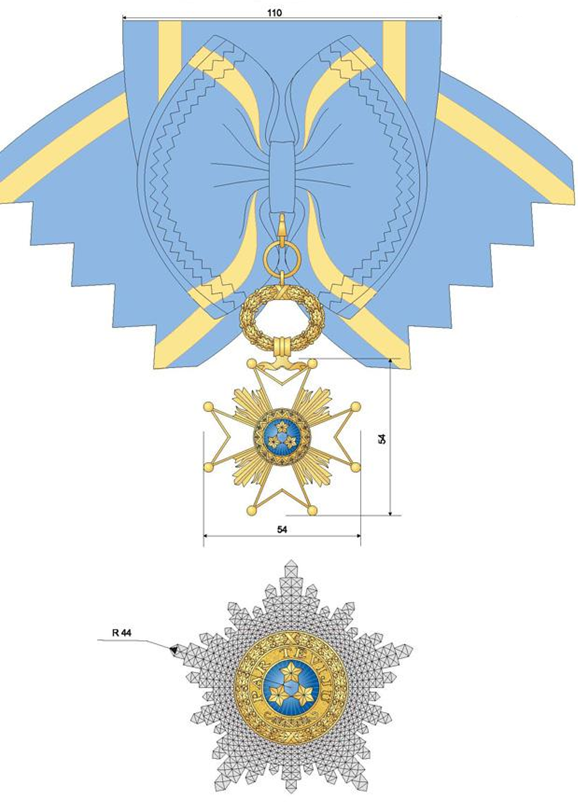
The Order of the
Three Stars
the star of the Commander of the
Great Cross of the Order and the cross with the ribbon of the
Order for gentlemen
Annex 2
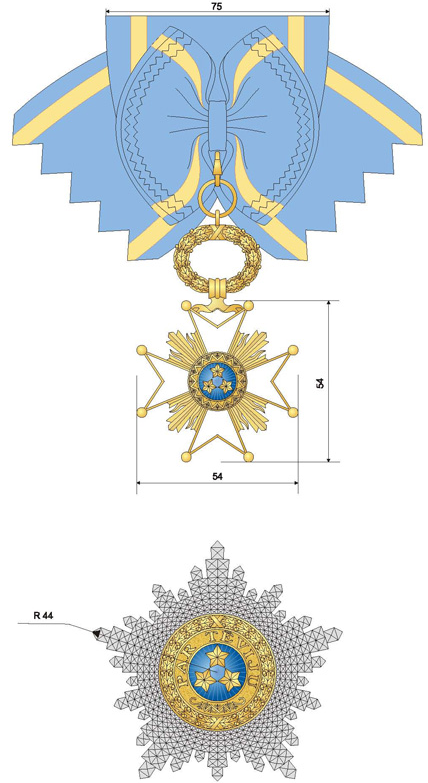
The Order of the
Three Stars
the star of the Commander of the
Great Cross of the Order and the cross with the ribbon of the
Order for ladies
Annex 3
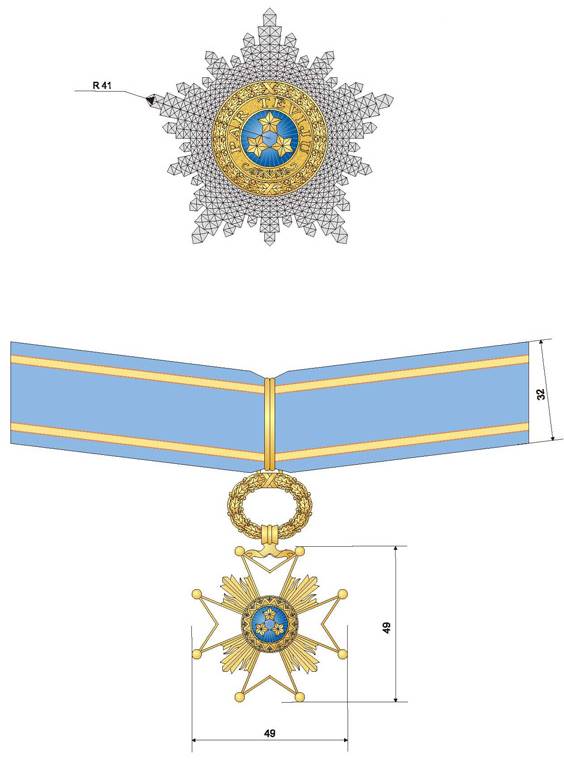
The Order of the
Three Stars
the star of the Grand Officer of
the Order and the cross with the ribbon of the Order for
gentlemen
Annex 4
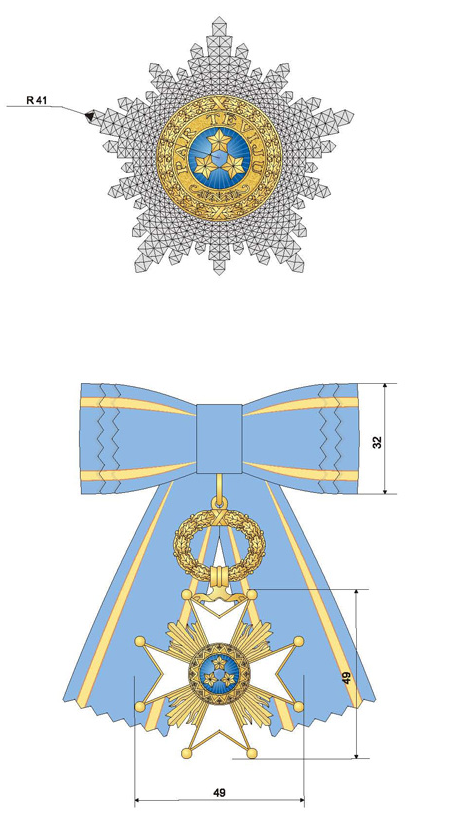
The Order of the
Three Stars
the star of the Grand Officer of
the Order and the cross with the ribbon of the Order for
ladies
Annex 5
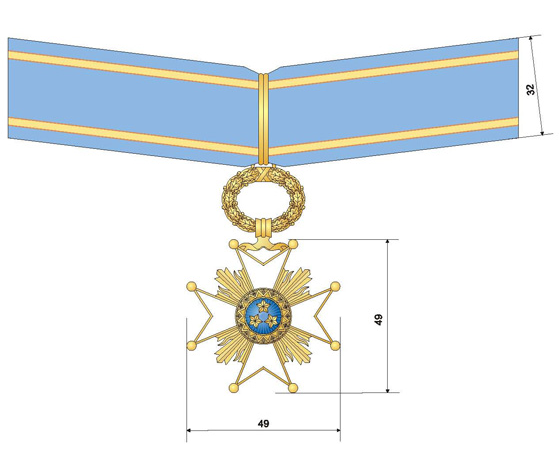
The Order of the
Three Stars
the cross of the Commander of the
Order with the ribbon of the Order for gentlemen
Annex 6
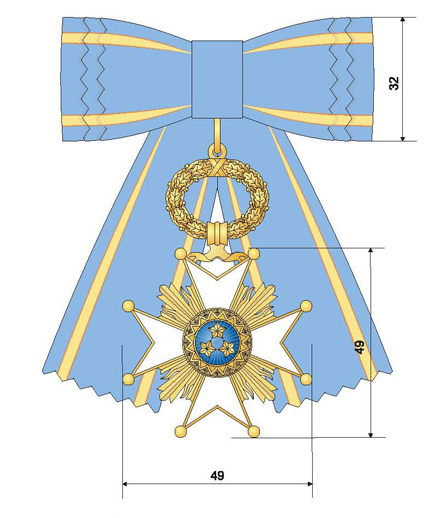
The Order of the
Three Stars
the cross of the Commander of the
Order with the ribbon of the Order for ladies
Annex 7
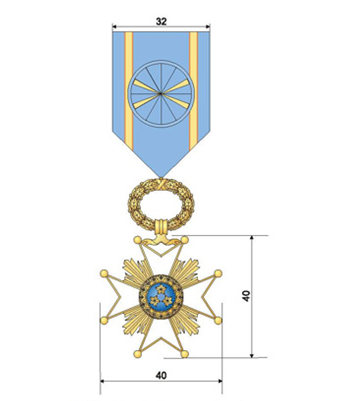
The Order of the
Three Stars
the cross of the Officer of the
Order with the ribbon of the Order for ladies and gentlemen
Annex 8
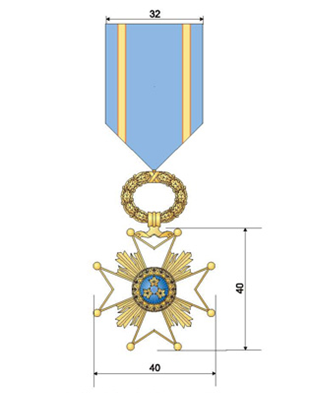
The Order of the
Three Stars
the cross of the Bearer of the
Order with the ribbon of the Order for ladies and gentlemen
Annex 9
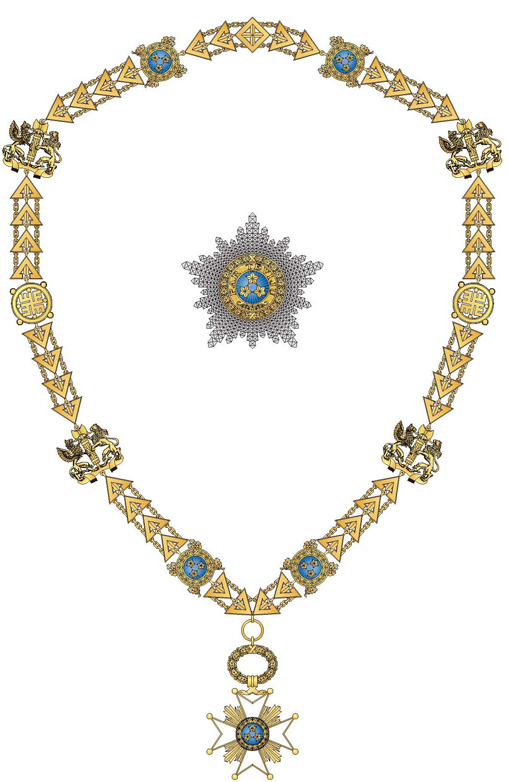
The Chain of the
Order of the Three Stars with the Cross of the Order and the Star
of the Order
Annex 10
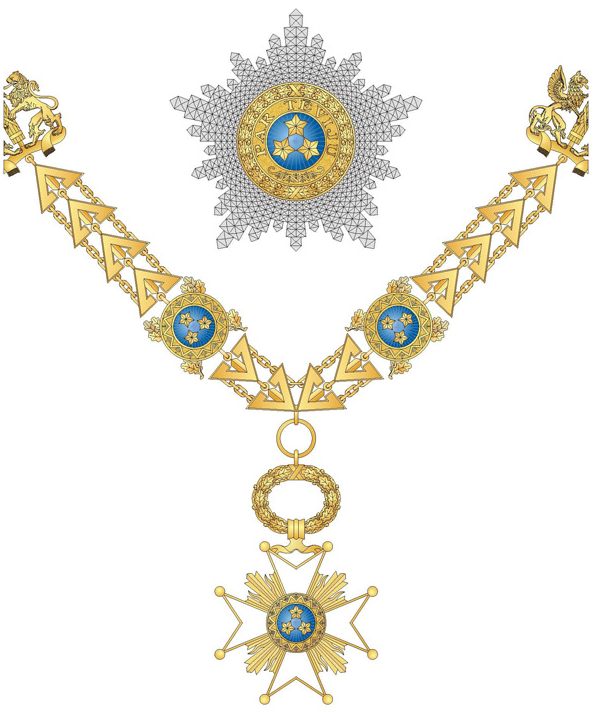
The Chain of the
Order of the Three Stars with the Cross of the Order and the Star
of the Order
Annex 11

Mark of the
Order of the Three Stars - Obverse of the Mark of the Order
Annex 12
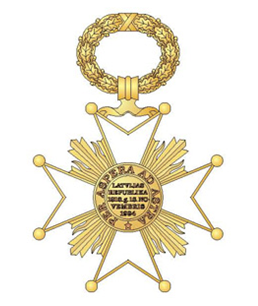
Mark of the
Order of the Three Stars - Reverse of the Mark of the Order
Annex 13
|
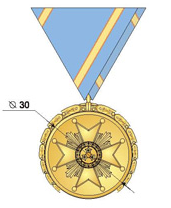
|
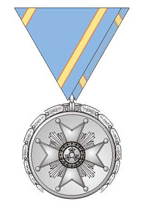
|
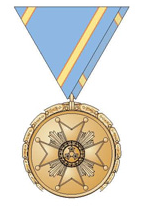
|
|
First Level
(gilded)
|
Second Level
(silvered)
|
Third Level
(bronzed)
|
Obverse of
Medals of Honour of the Order of the Three Stars
Annex 14
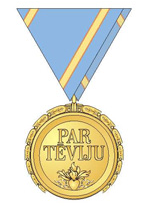
Reverse of
Medals of Honour of the Order of the Three Stars
Annex 15
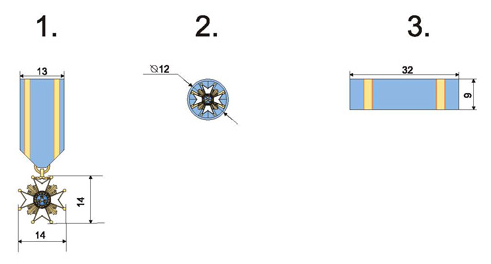
The Order of the
Three Stars
Miniature versions:
1. - a miniature mark of the Order
2. - the rosette of the ribbon of the Order
3. - a piece of the ribbon of the Order
Annex 16
|
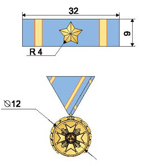
|
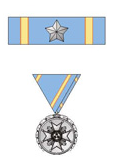
|
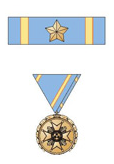
|
|
First Level
(gilded)
|
Second Level
(silvered)
|
Third Level
(bronzed)
|
Obverse of
Miniature Medals of Honour of the Order of the Three Stars and
Pieces of the Ribbon of the Order
Annex 17

Reverse of
Miniature Medals of Honour of the Order of the Three Stars
Annex 18
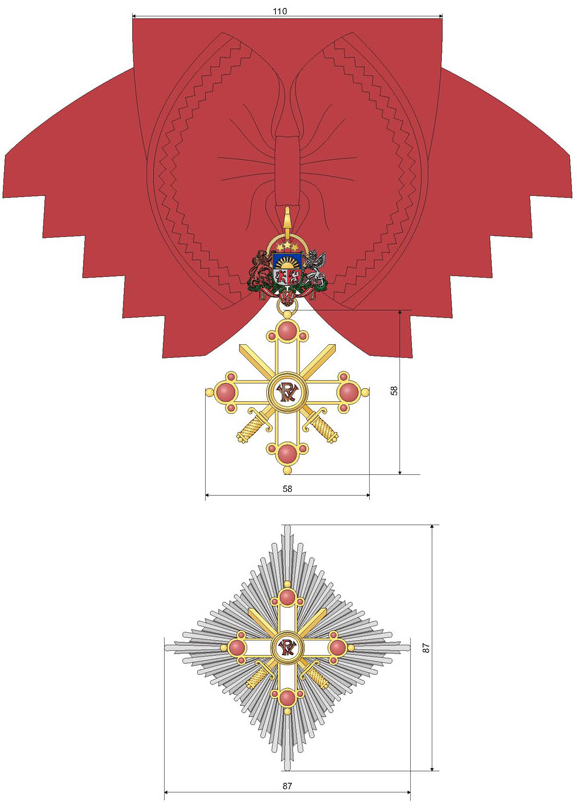
The Order of
Viesturs (with Spears)
the star of the Commander of the
Great Cross of the Order and the cross with the ribbon of the
Order for gentlemen
Annex 19
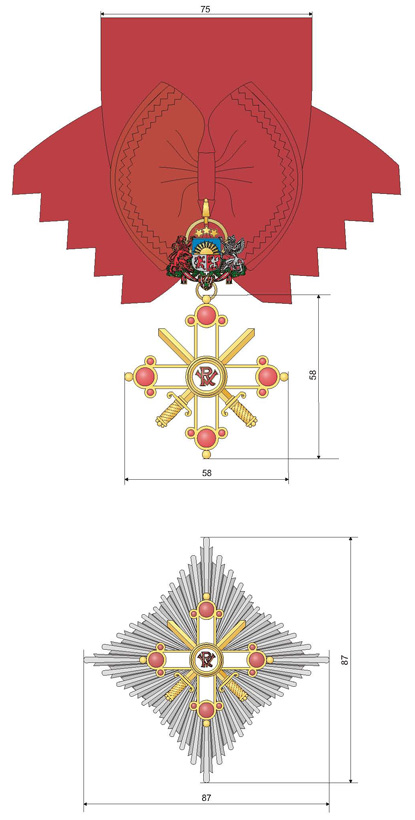
The Order of
Viesturs (with Spears)
the star of the Commander of the
Great Cross of the Order and the cross with the ribbon of the
Order for ladies
Annex 20
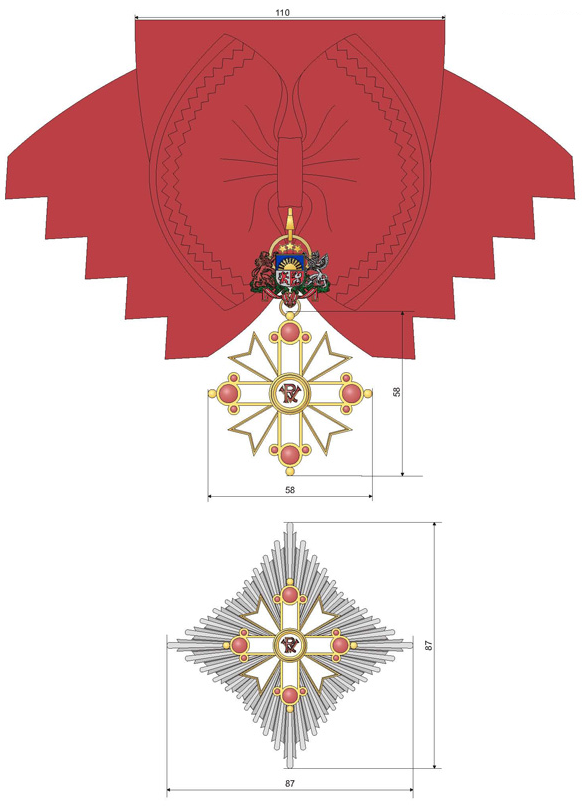
The Order of
Viesturs
the star of the Commander of the
Great Cross of the Order and the cross with the ribbon of the
Order for gentlemen
Annex 21
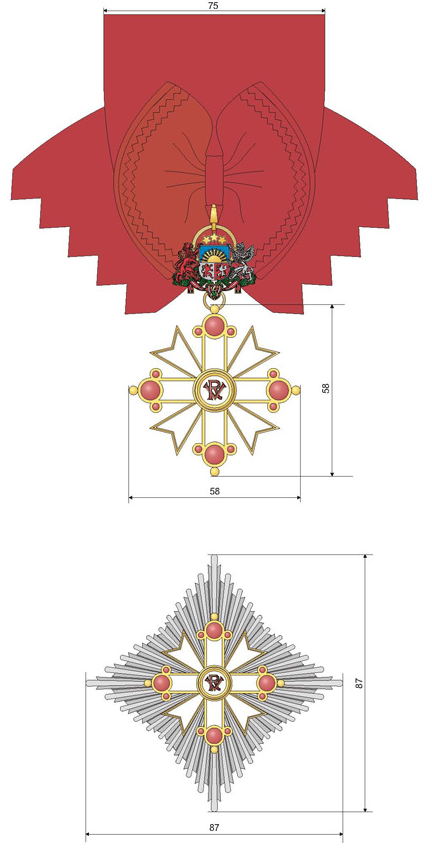
The Order of
Viesturs
the star of the Commander of the
Great Cross of the Order and the cross with the ribbon of the
Order for ladies
Annex 22
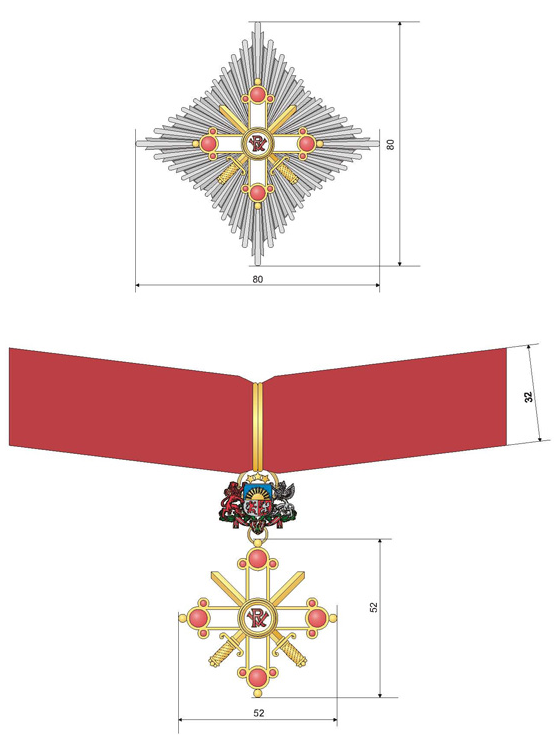
The Order of
Viesturs (with Spears)
the star of the Grand Officer of
the Order and the cross with the ribbon of the Order for
gentlemen
Annex 23
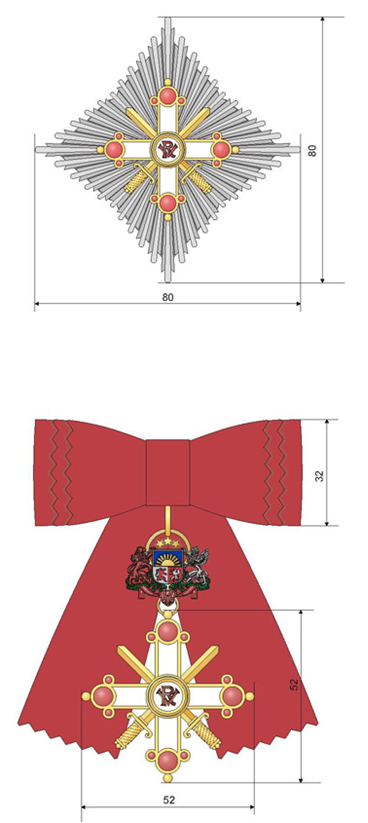
The Order of
Viesturs (with Spears)
the star of the Grand Officer of
the Order and the cross with the ribbon of the Order for
ladies
Annex 24
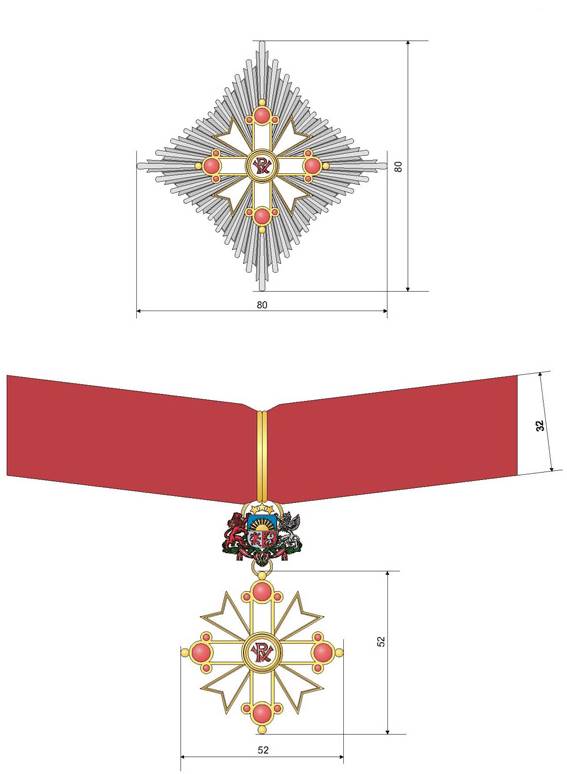
The Order of
Viesturs
the star of the Grand Officer of
the Order and the cross with the ribbon of the Order for
gentlemen
Annex 25
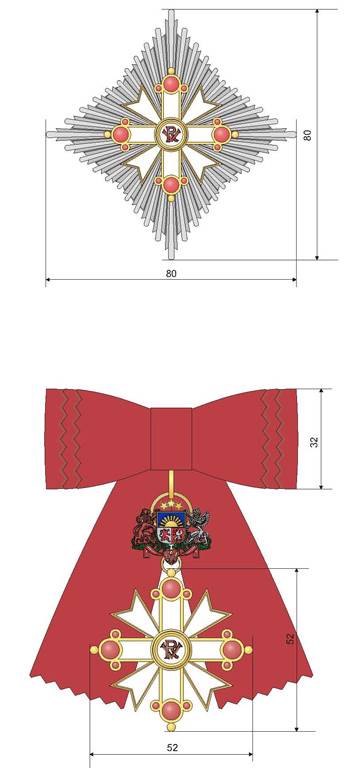
The Order of
Viesturs
the star of the Grand Officer of
the Order and the cross with the ribbon of the Order for
ladies
Annex 26
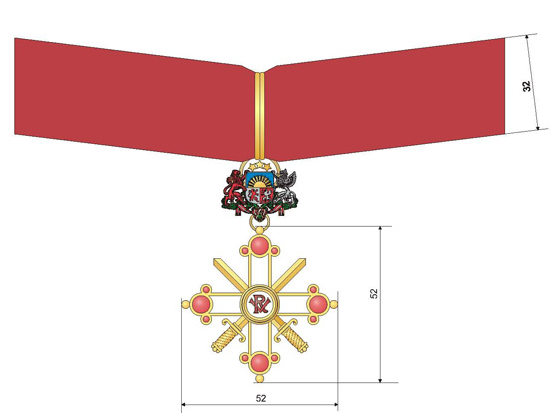
The Order of
Viesturs (with Spears)
the cross of the Commander of the
Order with the ribbon of the Order for gentlemen
Annex 27
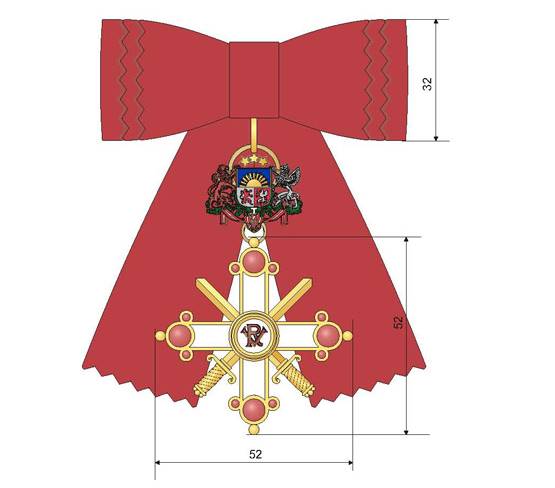
The Order of
Viesturs (with Spears)
the cross of the Commander of the
Order with the ribbon of the Order for ladies
Annex 28
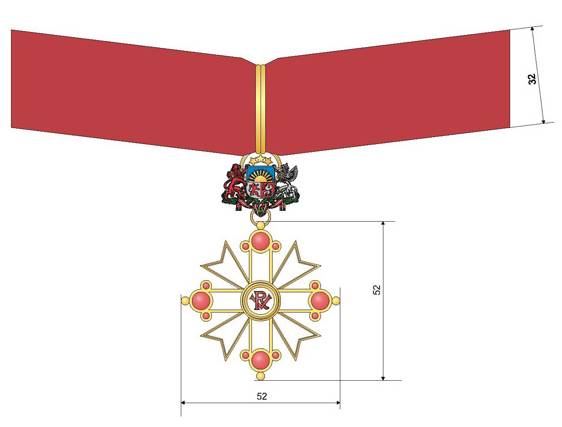
The Order of
Viesturs
the cross of the Commander of the
Order with the ribbon of the Order for gentlemen
Annex 29
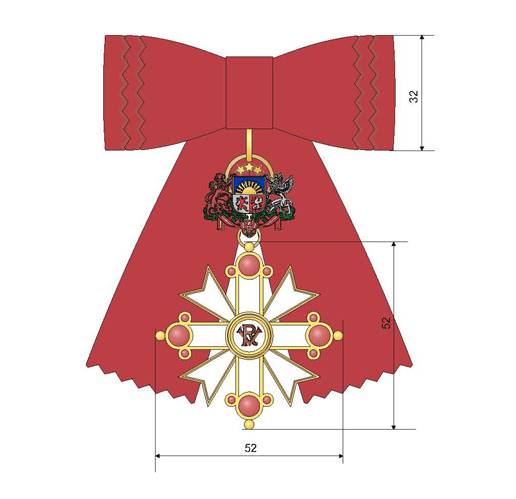
The Order of
Viesturs
the cross of the Commander of the
Order with the ribbon of the Order for ladies
Annex 30
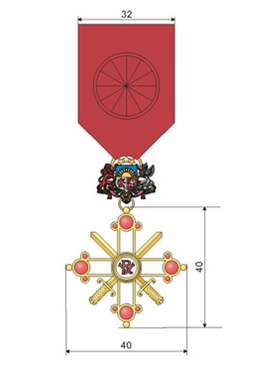
The Order of
Viesturs (with Spears)
the cross of the Officer of the
Order with the ribbon of the Order for ladies and gentlemen
Annex 31

The Order of
Viesturs
the cross of the Officer of the
Order with the ribbon of the Order for ladies and gentlemen
Annex 32

The Order of
Viesturs (with Spears)
the cross of the Bearer of the
Order with the ribbon of the Order for ladies and gentlemen
Annex 33

The Order of
Viesturs
the cross of the Bearer of the
Order with the ribbon of the Order for ladies and gentlemen
Annex 34
|
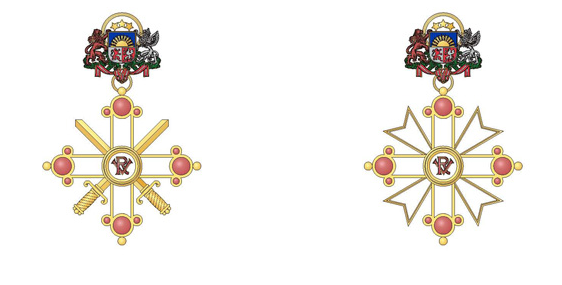
|
|
Mark of the
Order of Viesturs (with Spears) - Obverse of the Mark of
the Order
|
|
Mark of the
Order of Viesturs - Obverse of the Mark of the Order
|
Annex 35
|
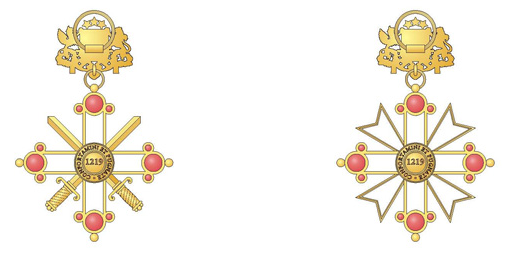
|
|
Mark of he
Order of Viesturs (with Spears) - Reverse of the Mark of
the Order
|
|
Mark of the
Order of Viesturs - Reverse of the Mark of the Order
|
Annex 36
|
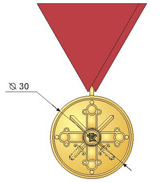
|
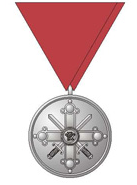
|
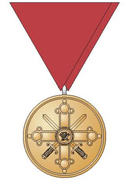
|
|
First Level
(gilded)
|
Second Level
(silvered)
|
Third Level
(bronzed)
|
Obverse of
Medals of Honour of the Order of Viesturs (with Spears)
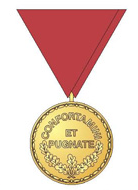
Reverse of All
Medals of Honour of the Order of Viesturs
Annex 37
|
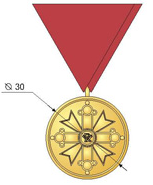
|
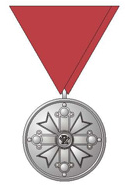
|
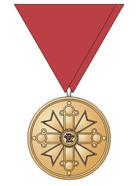
|
|
First Level
(gilded)
|
Second Level
(silvered)
|
Third Level
(bronzed)
|
Obverse of
Medals of Honour of the Order of Viesturs
Annex 38

The Order of
Viesturs (with Spears)
Miniature versions:
1. - a miniature mark of the
Order
2. - the rosette of the ribbon of the
Order
3. - a piece of the ribbon of the
Order
Annex 39
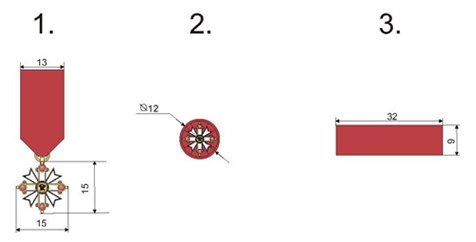
The Order of
Viesturs
Miniature versions:
1. - a miniature mark of the Order
2. - the rosette of the ribbon of the Order
3. - a piece of the ribbon of the Order
Annex 40
|
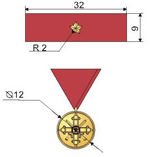
|
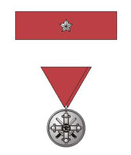
|

|
|
First Level
(gilded)
|
Second Level
(silvered)
|
Third Level
(bronzed)
|
Obverse of
Miniature Medals of Honour of the Order of Viesturs (with Spears)
and Pieces of the Ribbon of the Order

Reverse of All
Miniature Medals of Honour of the Order of Viesturs
Annex 41
|
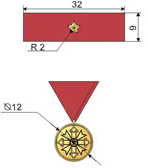
|

|
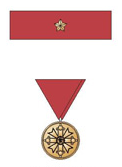
|
|
First Level
(gilded)
|
Second Level
(silvered)
|
Third Level
(bronzed)
|
Obverse of
Miniature Medals of Honour of the Order of Viesturs and Pieces of
the Ribbon of the Order
Annex 42
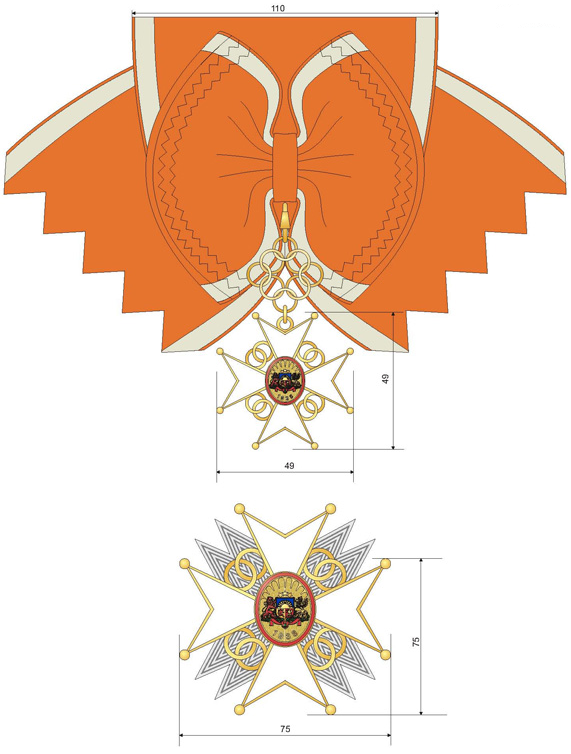
The Cross of
Recognition
the star of the Commander of the
Great Cross of the Order and the cross with the ribbon of the
Order for gentlemen
Annex 43

The Cross of
Recognition
the star of the Commander of the
Great Cross of the Order and the cross with the ribbon of the
Order for ladies
Annex 44
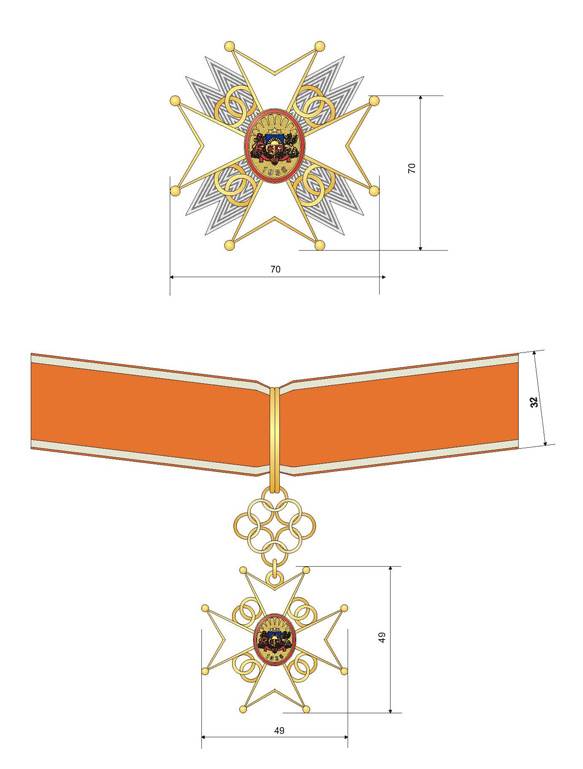
The Cross of
Recognition
the star of the Grand Officer of
the Order and the cross with the ribbon of the Order for
gentlemen
Annex 45
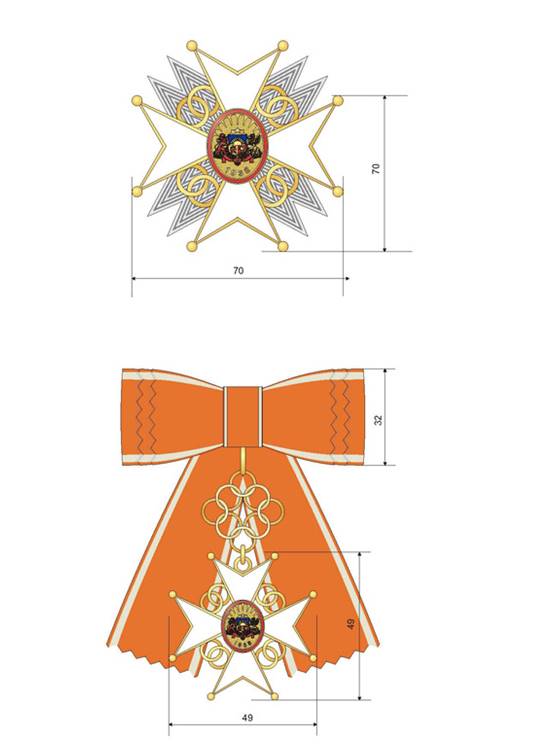
The Cross of
Recognition
the star of the Grand Officer of
the Order and the cross with the ribbon of the Order for
ladies
Annex 46
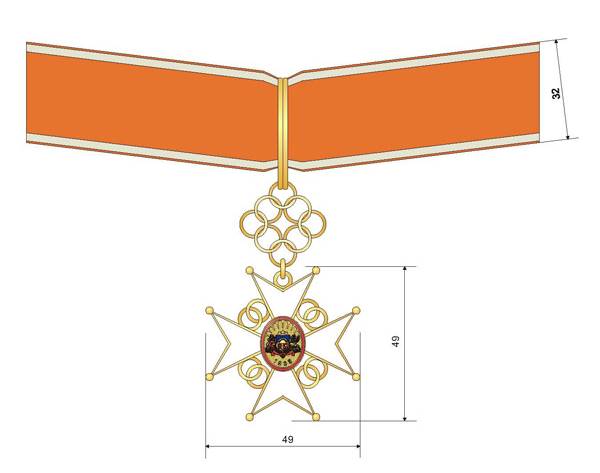
The Cross of
Recognition
the cross of the Commander of the
Order with the ribbon of the Order for gentlemen
Annex 47

The Cross of
Recognition
the cross of the Commander of the
Order with the ribbon of the Order for ladies
Annex 48
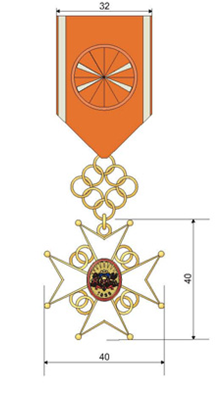
The Cross of
Recognition
the cross of the Officer of the
Order with the ribbon of the Order for ladies and gentlemen
Annex 49
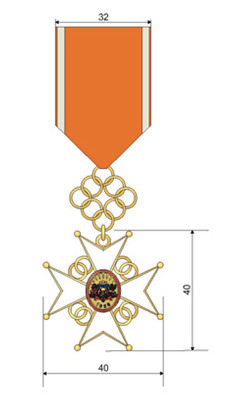
The Cross of
Recognition
the cross of the Bearer of the
Order with the ribbon of the Order for ladies and gentlemen
Annex 50
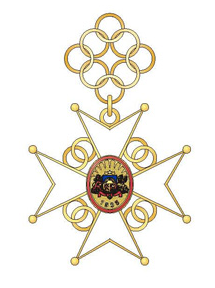
Mark of the
Cross of Recognition - Obverse of the Mark of the Order
Annex 51
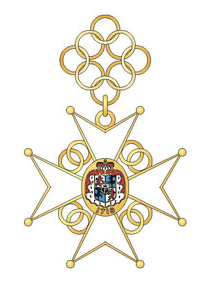
Mark of the
Cross of Recognition - Reverse of the Mark of the Order
Annex 52
|
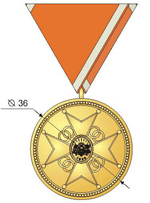
|
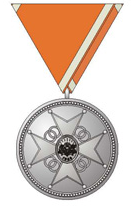
|

|
|
First Level
(gilded)
|
Second Level
(silvered)
|
Third Level
(bronzed)
|
Obverse of
Medals of Honour of the Cross of Recognition
Annex 53
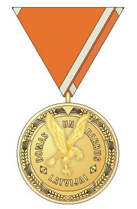
Reverse of
Medals of Honour of the Cross of Recognition
Annex 54
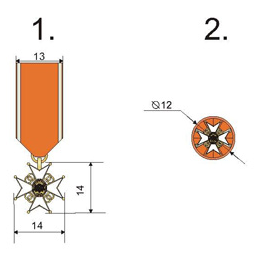
The Cross of
Recognition
Miniature versions:
1. - a miniature mark of the Order
2. - the rosette of the ribbon of the Order
Annex 55
|
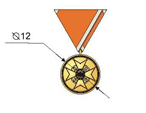
|

|

|
|
First Level
(gilded)
|
Second Level
(silvered)
|
Third Level
(bronzed)
|
Obverse of
Miniature Medals of Honour of the Cross of Recognition

Reverse of
Miniature Medals of Honour of the Cross of Recognition
1 The Parliament of the Republic of
Latvia
Translation © 2022 Valsts valodas centrs (State
Language Centre)




